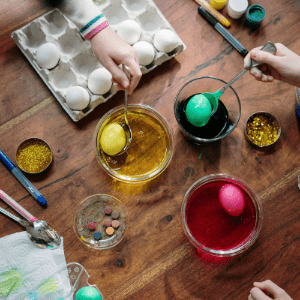Three ways to plan a low-waste Easter egg hunt

Three ways to plan a low-waste Easter egg hunt
Like many holidays, Easter can end in a lot of packaging waste. To help you have a more eco-friendly spring, Scott Hawthorne from SkipsAndBins.com shares his tips for planning a low-waste Easter egg hunt for the kids.

What would Easter be without eggs? Planning an Easter egg hunt is a great way to keep the little ones in your care entertained this spring. But often Easter egg hunts can result in a lot of packaging which is sent straight to landfill. Luckily, there are a few ways you can make your Easter more eco-friendly — and they could actually make it even more fun!
Below, I'll be going through my top tips for planning a low-waste Easter egg hunt.
Choose sustainable eggs
The most important part of an Easter egg hunt is, of course, the eggs. Unfortunately, most commercially available chocolate eggs come with a whole load of packaging like plastic, cardboard, and foil. Although most of this packaging can be recycled, some eggs come with vacuum moulded plastic packaging that can only be disposed of in your general waste bin. Plus, most Easter eggs come with an extra treat such as a chocolate bar or bag of sweets, and this packaging can't be recycled, either.
Some eggs do contain recyclable plastic, but this can often be disposed of incorrectly and can end up in landfill. And, once they reach landfill, these plastics can't biodegrade, which means they can sit there for hundreds of years before the sun's UV rays eventually begin to break them down.
As an alternative, look for sustainable brands that use recyclable cardboard and foil and avoid plastic if you can. Some big brands, such as Nestlé, are now opting for plastic-free packaging, so you're bound to find a suitable selection for little ones.
You could also consider making your own Easter eggs by pouring melted chocolate into moulds and enlisting some little helpers to decorate each one. Wrap them in tissue paper as an eco-friendly alternative to foil. Or you could make traditional versions by dipping eggs in different coloured dyes or painting them. The kids are bound to love making their own eggs and preparing for their hunt!
If you're using refillable Easter eggs, try to buy sustainable versions, such as those made from wood or felt, rather than plastic varieties.
Reuse leftover chocolate
After your Easter egg hunt, you'll no doubt be left with plenty of chocolate that the kids can't eat (at least not all at once!). Instead of throwing it away, you can cut down your food waste and reuse it for an activity on another day. For example, you could melt it down and make Rice Crispy or Cornflake cakes or mix in some marshmallows and crushed biscuit pieces to make rocky road. You could also add it to a blender with some vanilla ice cream to make chocolate milkshakes for everyone to enjoy.
Recycle waste correctly
Even a low-waste Easter egg hunt can still create some packaging waste, and it's important to collect it and dispose of it correctly. Enlist the help of the children to teach them the importance of tidying up after themselves. Then, you can sort through your packaging to decide what to do with it.
Cardboard and paper can be recycled for crafts, and you could use them to make fun Easter themed masks and bonnets. If they can't be reused, then you can recycle them in your ordinary dry mixed recycling bin.
Foil can usually be recycled as long as it's aluminium foil. To work out what it's made from, scrunch it into a ball. If it stays scrunched up, it's made from aluminium and can be recycled in your dry mixed recycling bin. If it returns to its original shape, then it contains a plastic film that can't be recycled.
If your foil has traces of chocolate left on it, then it's best to wash it off before recycling it. And remember to scrunch your recyclable foil into one large ball, as this will make it easier for the recycling machines to detect it.
If you haven't been able to avoid plastic packaging, then it's wise to always check the label on the back of the package to see if it can be recycled. Most plastic packaging on food is made from PET which can be washed and recycled in your usual recycle bin. However, some other forms of plastic, such as sweet wrappers, can't be recycled easily, so it's always worth checking with your local authority or waste management company to see if they'll take them.
Don't let packaging waste ruin your Easter festivities. By following the tips above, you can plan a low-waste Easter egg hunt that the kids are bound to love!